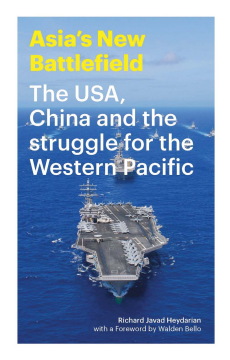
Additional Information
Book Details
Abstract
This compact, insightful book offers an up-to-the-minute guide to understanding the evolution of maritime territorial disputes in East Asia, exploring their legal, political-security and economic dimensions against the backdrop of a brewing Sino-American rivalry for hegemony in the Asia-Pacific region. It traces the decades-long evolution of Sino-American relations in Asia, and how this pivotal relationship has been central to prosperity and stability in one of the most dynamics regions of the world. It also looks at how middle powers – from Japan and Australia to India and South Korea – have joined the fray, trying to shape the trajectory of the territorial disputes in the Western Pacific, which can, in turn, alter the future of Asia – and ignite an international war that could re-configure the global order.
The book examines how the maritime disputes have become a litmus test of China’s rise, whether it has and will be peaceful or not, and how smaller powers such as Vietnam and the Philippines have been resisting Beijing’s territorial ambitions. Drawing on extensive discussions and interviews with experts and policy-makers across the Asia-Pacific region, the book highlights the growing geopolitical significance of the East and South China Sea disputes to the future of Asia – providing insights into how the so-called Pacific century will shape up.
Richard Javad Heydarian is an assistant professor in political science and international relations at De La Salle University, the Philippines, and served as a foreign policy adviser at the Philippine House of Representatives from 2009 to 2015. He has also been a consultant for various national and international institutions, advising on economic and foreign policy issues concerning the Philippines and East Asia. His previous works include How Capitalism Failed the Arab World (Zed 2014).
‘A valuable source for policy makers, academics, researchers and those who would like to understand the dynamics among the powers in Southeast Asiae.’
Wilfrido Villacorta, former Philippine ambassador and permanent representative to ASEAN
‘Robustly argued, thoroughly researched, and engagingly written... Heydarian’s coverage of Southeast Asia is a proverbial breath of fresh air.’
Salvatore Babones, Asian Review of Books
‘If you only read one book on Asian security issues, it should be this.’
Harry J. Kazianis, Center for the National Interest
‘A valuable guide to the increasingly volatile contest between the United States and China.’
Bill Hayton, author of South China Sea: The Struggle for Power in Asia
‘Combining lucid analysis with rich data and elegant prose, Heydarian’s book is a must-read for anyone who is interested in the future of Asia.’
Alexander Vuving, Asia-Pacific Center for Security Studies
Table of Contents
| Section Title | Page | Action | Price |
|---|---|---|---|
| Front Cover | Front Cover | ||
| Book Epigraph | i | ||
| About the Author | ii | ||
| Title Page | iii | ||
| Dedication & Copyright | iv | ||
| Contents | v | ||
| Figures and Tables | vi | ||
| Acknowledgements | viii | ||
| Foreword | xi | ||
| Introduction | 1 | ||
| The Seismic Shift | 4 | ||
| An Inscrutable Challenge | 10 | ||
| Asia’s New Battlefield | 14 | ||
| 1 | The Great Convergence: Sino-American Symbiosis | 17 | ||
| The Liberal Experiment | 18 | ||
| China’s Soul-Searching | 20 | ||
| The Architect of Reform | 24 | ||
| China’s Charm Offensive | 33 | ||
| Signs of Trouble | 45 | ||
| 2 | The Revenge of History | 52 | ||
| American Retrenchment | 57 | ||
| New World Disorder | 63 | ||
| The Tide of Nationalism | 67 | ||
| A New Paramount Leader | 74 | ||
| 3 | War at Sea: From the Motherland to the Blue Soil | 88 | ||
| Economic Codependence | 89 | ||
| The Beijing Consensus | 93 | ||
| Consolidating the Motherland | 97 | ||
| The Anatomy of a Crisis | 107 | ||
| 4 | Between an Eagle and a Dragon: The Tragedy of Small-Power Politics | 143 | ||
| A History of Dependency | 144 | ||
| Raising the Stakes | 160 | ||
| Taking on China | 162 | ||
| 5 | The Middle Powers: A Game of Thrones | 204 | ||
| The Pivot and Its Discontents | 208 | ||
| Japan Steps In | 217 | ||
| Reinventing Japan | 226 | ||
| Towards a ‘Normal’ Japan | 229 | ||
| A New Era? | 235 | ||
| The Rise of Others | 240 | ||
| The Other Guys | 260 | ||
| 6 | After Hegemony: Towards a Pacific Community | 270 | ||
| A New Security Architecture | 274 | ||
| References | 325 | ||
| Index | 347 | ||
| Back Cover | Back Cover |
